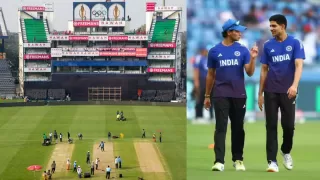3 Reasons Why Team India Lost 1st Test India vs England at Headingley

The 1st Test between India and England at Headingley was a rollercoaster. India came in with high hopes, boasting a star-studded lineup, but walked away with a bitter defeat. England, navigating tricky conditions, clinched a 1-0 lead in the series that promised fireworks.
While India’s batsmen lit up the scoreboard, their downfall came from a mix of batting collapses, fielding blunders, and a lackluster bowling effort on the final day. Let’s break down the three key reasons why Team India lost the 1st Test India vs England.
1. Batting Collapses That Cost the Game
India’s top order was a sight to behold. Shubman Gill (147), Yashasvi Jaiswal (101), and Rishabh Pant (134) powered India to a commanding 471 in the first innings. Pant even made history in the second innings, becoming the first Indian to score twin centuries in England alongside KL Rahul’s 100. But the lower-middle order? That’s where things fell apart.
In the first innings, India was cruising at 430/3. Then, disaster struck. The last seven wickets tumbled for just 41 runs, leaving them at 471 all out. The second innings wasn’t any better. From a solid 333/4, India lost their last six wickets for a measly 31 runs, setting England a target of 371. Those missing 50-100 runs across both innings could’ve made all the difference.
Players like Karun Nair, Ravindra Jadeja, and Shardul Thakur couldn’t hold fort, exposing India’s fragile tail and handing England a chaseable total.
2. Fielding Lapses That Let England Off the Hook

If India’s batting collapses were bad, their fielding was a nightmare. Dropped catches turned the match on its head. England’s Ollie Pope (dropped at 60), Harry Brook (missed twice at 46 and 82), and Ben Duckett in the second innings all got lifelines. These weren’t just minor errors; they were game-changers.
Yashasvi Jaiswal, usually reliable, had a horror show, dropping four catches. Rishabh Pant, Ravindra Jadeja, and Sai Sudharsan also fluffed their lines. These misses allowed England’s batsmen to pile on runs, with Pope’s 106 and Brook’s 99 in the first innings setting the tone.
In the second innings, Duckett’s 149 capitalized on India’s sloppiness, swinging momentum firmly England’s way. Those extra runs and extended partnerships put India under pressure, and their batting couldn’t recover from the setback.
3. Toothless Bowling on the Final Day
Day 5 was India’s chance to seal the deal. England needed 351 runs with 10 wickets in hand—a tough but achievable target. India’s bowlers, however, came up short. Despite overcast conditions perfect for swing and seam, the pace attack looked flat. Jasprit Bumrah, India’s spearhead, was unusually quiet, going wicketless in his opening spell. England’s openers, Zak Crawley (65) and Ben Duckett (149), made the most of it, racing toward the target.
Shardul Thakur and Prasidh Krishna grabbed a couple of wickets each, but the breakthroughs were too late. Ravindra Jadeja, expected to trouble England on a wearing pitch, was subdued and failed to make an impact. England’s batsmen, led by Duckett’s scintillating century and supported by Joe Root and Ben Stokes, navigated the chase with ease. India’s inability to strike early or build pressure let England dictate terms, sealing India’s fate in the 1st Test India vs England.
Beyond the obvious flaws, India’s approach showed cracks in strategy. The bowlers’ lines and lengths on Day 5 were inconsistent, failing to exploit the conditions. Bumrah, usually a master at unsettling batsmen early, bowled too predictably, allowing England’s openers to settle. Jadeja’s lack of variation meant England’s batsmen could play him out comfortably.
Field placements also raised eyebrows. With England chasing a big total, India’s captain, Shubman Gill, opted for defensive fields too early, giving Duckett and Crawley easy singles. This allowed England to rotate strike and keep the scoreboard ticking without taking risks. Add to that the mental toll of dropped catches, and India’s body language looked defeated by the second session. These small but critical errors compounded India’s woes, turning a winnable game into a frustrating loss.
Conclusion
India’s defeat in the 1st Test against England at Headingley was a gut punch. Their batsmen showed flair, with Gill, Jaiswal, Pant, and Rahul delivering stellar performances. But cricket isn’t just about batting. India’s lower-order collapses, shoddy fielding, and lackluster bowling on the final day handed England a well-earned victory. Tactical missteps, like poor field placements and inconsistent bowling plans, only made things worse.
As India heads into the 2nd Test on July 2, they’ve got work to do. Tightening up their fielding, ensuring their lower order contributes, and rediscovering their bowling edge will be key. England’s 1-0 lead puts them atop the World Test Championship table, but India’s talent runs deep. If they can learn from these mistakes, they’re more than capable of bouncing back. For now, though, Headingley will sting, a reminder that even the best teams can falter when the basics go wrong.
Disclaimer
Possible11 is a sports news platform that provides live scores, player statistics, and tournament updates for informational and educational purposes only. We comply with the Online Gaming Bill, 2025 (India) and do not promote or engage with fantasy sports, betting, or real-money gaming platforms. All content is intended solely to enhance the sports experience. Possible11 is not affiliated with any fantasy or gambling applications and is not responsible for any financial gains or losses incurred on external platforms.











Give Your Feedback